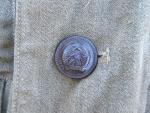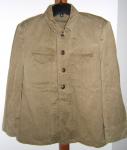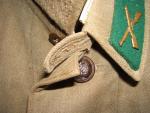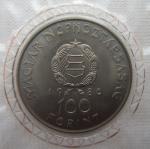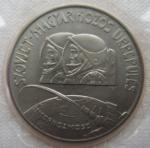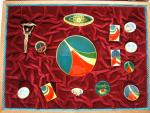-
Posts
4,807 -
Joined
-
Last visited
-
Days Won
12
Content Type
Profiles
Forums
Blogs
Gallery
Events
Store
Everything posted by Gordon Craig
-

Hungary Hungarian Red Cross Awards
Gordon Craig replied to Gordon Craig's topic in Central & Eastern European States
Gents, Just when I was becoming sure that all Hungarian Red Cross badges, awards etc. were issued in blue cases I find one in a red case. I bought this small 10 donor pin yesterday and it ceratinly was made for the box it came. First one I have seen in the case. Regards, Gordon -

DDR Zivilverteidigung (Civil Defense)
Gordon Craig replied to Hauptmann's topic in Germany: Post 1945: Bundesrepublik & DDR
Dan, Re the side cap. It is correct as shown for a ZV officer. However, as a field cap it would probably not have been worn with the uniform you purchased. The peaked cap in your photo would be the correct wear. Regards, Gordon -
Alex, The first hat is for the Volkespolizei (VOPO) and the second one is for the Transportation Police (TRAPO). Regards, Gordon
-

DDR 30 years of the NVA
Gordon Craig replied to Grant Broadhurst's topic in Germany: Post 1945: Bundesrepublik & DDR
Grant, I don't have one of these medals nor do I have a oicture of the back of one but I have no doubt that the one you pictured is authentic. It is not unusual for DDR medals to have small letters at the bottom on the reverse side as this one does. Perhaps someone who has more knowledge of these medals will provide a better answer. Regards, Gordon -
Gents, A little more to add this thread. I was able to acquire one of the MSzSz books at the last monthly militaria show. The stamps in my book start at approximately the same time as those in Charles' book. His in Oct. 1948 and mine in Nov. 1948. Unfortunately, when you buy at a militaria show vendors have a better idea of what things are worth than most antique dealers so I had to pay considerably more for mine that Charles did for his. Regards, Gordon
-
Gents, This is probably of general interest to all GMIC members but since my responsibility is only to this forum I am going to post this info that I received today from an auction house in the U.S. here. I can not answer any questions on this change. This is the only info that I have. I do not know how this will affect things mailed to the U.S. Perhaps one of the U.S. members can check with their local post office and give us a more complete report. Regards, Gordon As of Monday, May 14, 2007, The United States Postal Service will discontinue International Surface Shipping. The only shipping via the United States Postal Service for international will be International Priority and Air Letter.
-

Hungary Hungarian Kivalo Dolgozol Badges
Gordon Craig replied to hunyadi's topic in Central & Eastern European States
Ulsterman, I would say that the Kivalo shown has the cim glued into place. I/we often find them with the cim loose and I just glue it back in place with crazy glue. Regards, Gordon -

Hungary Hungarian Kivalo Dolgozol Badges
Gordon Craig replied to hunyadi's topic in Central & Eastern European States
Ulsterman, It is possible Charles is refering to your "motherload" comment when he says "When can we see them?". You really peeked my curiosity with that comment. Regards, Gordon -

Hungary Armed Forces Uniforms
Gordon Craig replied to hunyadi's topic in Central & Eastern European States
-

Hungary Armed Forces Uniforms
Gordon Craig replied to hunyadi's topic in Central & Eastern European States
-

Hungary Armed Forces Uniforms
Gordon Craig replied to hunyadi's topic in Central & Eastern European States
Here is another tunic of the same type that I bought last Saturday at the Budapest Militaria Show. This tunic has no shoulderboards nor collar tabs and no indication that they were ever applied. I want to use it to illustrate an anamoly pecurliar to these tunics. The loops for attaching the shoulder boards are the same at the shoulder end as they are on other tunics of this period except there is no obvious way to attache the shoulder boards at the collar end. Other tunics of this period use one of two silimar methods; 1-a wide cloth loop at the shoulder end and a thin thread loop at the collar end; 2-a thin thread loop at the shoulder end and a thin thread loop at the collar end. In both of these methods the button is never attached to the tunic. It is inserted through the top of the shoulder board while the shoulder board tab is inserted through both loops on the tunic. The loop on the back of the button is then pushed through the shoulder board tab and either tied into place with a piece of cloth or sometime just a small piece of wood is used to hold the button in place and secure the shoulder board to the tunic. On the Infantry tunic that I posted pictures of previously, an earlier owner has made two holes in the tunic at the collar end and tied the shoulder board on by inserting a piece of cloth through the button loop and pushing the two ends of this piece of cloth through the two holes in the tunic shoulder before tying it inside the tunic. Much the same as was done in the DDR NVA to attach shouder boards. -

Hungary Armed Forces Uniforms
Gordon Craig replied to hunyadi's topic in Central & Eastern European States
A close up of the collar showing the collar tabs and crossed rifles as well as the collar closure tab and associated button. -

Hungary Armed Forces Uniforms
Gordon Craig replied to hunyadi's topic in Central & Eastern European States
-

Hungary Armed Forces Uniforms
Gordon Craig replied to hunyadi's topic in Central & Eastern European States
Gents, Time to add some more uniforms to this reference thread that Charles started for this purpose. The first uniform I will post pictures of is tunic from the same era as Charles M51 Panzer Tunic. It is the two pocket everyday service tunic. Made of a rough cotton type of material instead of the high quality wool of the M51 Panzer Tunic. It has 5 plastic buttons on the front and none for the pockets. Instead of closing the neck with a hook and eye there is a cloth tab on one side and a small brown plastic button on the other. Charles and I have not been able to find any reference for this method of closing the nexk. Also not that the white collar liner is made of a stiff plastic material. The collar liner has a series of small holes along the top and bottom that are used to sew the collar liner to the tunic. This tunic is well marked as being manufactured in 1955. This tunic is for a third Liutenant in the Infantry. Note the small stars used for rank indication. The stars were also "flater" during this time period than later rank stars. This is indicated by the green arm of service and the crossed rifles. -

Hungary Hungarian Kivalo Dolgozol Badges
Gordon Craig replied to hunyadi's topic in Central & Eastern European States
Ulsterman, There was a book done on these badges but Charles and I ahve been unsuccessful in acquiring a copy. We got to look at one at the National Museum but that is as close as it got. Regards, Gordon -

Hungary Hungarian Hyperinflation
Gordon Craig replied to hunyadi's topic in Central & Eastern European States
Charles, Thanks. I should have worked that out for myself! Regards, Gordon -

Hungary Hungarian Presentaion Set
Gordon Craig replied to order_of_victory's topic in Central & Eastern European States
Order of Victory, Welcome the select few of us who have managed to acquire a presentation case of Hungarian armed forces awards. Regards, Gordon -

Hungary Hungarian Hyperinflation
Gordon Craig replied to hunyadi's topic in Central & Eastern European States
Charles, Great article. Gor any extra Pengos? Cheers, Gordon -

Hungarian Hyperinflation
Gordon Craig replied to hunyadi's topic in Coins & Commemorative Medallions
Charles, Very interesting stuff. Great looking bank notes with areal history to tell. Regards, Gordon -

DDR Erich Mielkes Parade Car
Gordon Craig replied to Gordon Craig's topic in Germany: Post 1945: Bundesrepublik & DDR
Christophe, Here is the URL for the car auction. https://www.pastbuy.net/lo/galerie.php?ObjI...ode=P&pic=1 Grant, Not a car for me. I don't care for Volvo's. I'll stick with my Jaguar. The other option is a BRM 2 from Hungarian syrplus vehicles although my wife woul kill me! Cheers, Gordon -
Zsolt, Thanks for posting your set of Soyus 36 badges. Nice to know there are two different sets available. Yours most certainly is the "official" set but someone did a really great job producing the set I bought on Saturday. Were the red cased sets given out at a specific time or to specific people? Regards, Gordon
-

DDR Erich Mielkes Parade Car
Gordon Craig posted a topic in Germany: Post 1945: Bundesrepublik & DDR
Gents, Here is something that you just can not do without in your collection. The parade car reportedly used by Erich Mielkes is for sale in Germany. It is a lengthened 1976 P254 in black. For a meer 25,000 Euros it can be yours! Regards, Gordon



